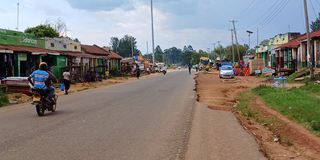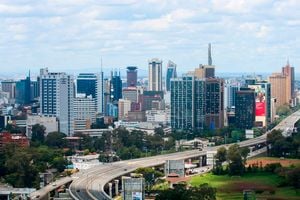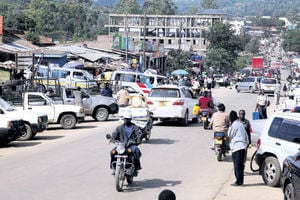
Butere town in Kakamega County. The ancient town has 'refused to grow'.
Every time Abdallah Nyangweso, a resident of Butere town, wants to make a bank transaction, he has to travel to Mumias, about 15 kilometres away to get the bank services.
For the last 15 years, since he was posted as a teacher in Butere sub-county, Mr Nyangweso, who teaches at Shiatsala Secondary School has had to endure the hassle of travelling far just to get a bank.
"It is not only expensive but it wastes a lot of my time and it is tiresome. I wish there was a bank in Butere to save us from this inconveniencing experience," says Mr Nyangweso.
The teacher is among hundreds of residents of Butere struggling to get basic services in a town whose growth has stunted.
Residents say the town, located in Kakamega County, has ‘refused to grow’ despite its age and the prominent people it has produced in Kenya’s leadership circle.
The town has no bank, no supermarket, no designated public space for recreational activities and no bus park. The only grounds available are within the existing institutions.

A man stands outside one of the oldest buildings in Butere town.
As other satellite towns grow and turn into investment hotspots for developers looking to build high-rise apartments and offices, banks, fancy nightclubs bars and shopping malls, what Butere boasts of is a police station, a district headquarters, a court, a livestock ring, a market and two major secondary schools.
'The Butere I remember'
Josphat Ongachi, a resident of Butere of the 1960s tells Nation Lifestyle about the Butere he remembers.
The market days were charming, he says. Butere market was the melting pot of traders from Sabatia and Shiatsala. Over time, however, areas such as Sabatia have grown and overtaken Butere.
"I attribute this partly to Sabatia’s location on the main road that goes to Kisumu and Kakamega. Butere is hidden away from the main road," he says.
"Another exciting thing I remember was the open visits to Butere Boys and Butere Girls. Whenever the schools had activities, the community would be invited to participate. Our Anglican upbringing was strengthened by Sunday School which was run by Christian Union girls and boys from Butere Girls and Boys," he says.
Butere Girls has since been elevated to a national secondary school and there is little interaction between the community and students.
"Another interesting place was the railway station. It was the first place we saw running water. The railway station no longer works. If they revive the railway it will help to promote traders and make the town more vibrant," Mr Ongachi says.
There was also a jaggery-making plant that made the town vibrant, but it has since closed.
"I remember a jaggery that was run by an Indian. This was closed down and the Indians left. Perhaps that represents the biggest promise of industrialisation in Butere, which seems to have gotten off to a false start," he says.
Good old days
Mr Ongachi reminisces about the good old days, when public holidays brought together residents and all area leaders.
"We would attend the public holiday ceremony. We listened to speeches and enjoyed good music. These events were hosted at the D.O’s [District Officer] office, which was in Butere town between the upper shops and the lower shops. I don’t think we still have any organising of that nature any more," he says.
Back then, they also had a working post office with all the activities of a post office such as sending and receiving money orders, selling postage stamps and sending and receiving parcels. The place has since been converted into a hotel.
"If Mumias Sugar Company is revived, it will help. The company had an office in Butere. Back then infrastructure was the problem. But right now we have tarmacked roads; we also have power and water everywhere," Mr Ongachi says.
Butere town is the headquarters of Butere sub-county and is linked by roads to Mumias in the North, Kisumu in the South East and Siaya in the West. Until 2010, the town was the headquarters of the former Butere-Mumias District.
Abatere were the predominant inhabitants of Butere until the Europeans selected the area as a base for their administrative tasks. Largely the Marama sub-tribe of the larger Luhyia Community inhabits Butere town, with a significant number of Luo immigrants from the neighbouring Siaya County. The population of Butere town is estimated at 7,596 (according to the 2019 census).
A branch of the railway line from Kisumu ends in Butere town hence the famous name ‘Mwisho wa reli’ (end of the railway line).

A renovated office at Butere station. The renovations were carried out in 2021 in anticipation of the resumption of rail services, which are yet to materialise.
The railway line branching from the main line to Uganda served the Butere area but the service has since been suspended from operations but the infrastructure remains existent. The anticipated SGR [standard gauge railway] is expected to utilise the infrastructure to reawaken the town.
Oldest businessman
Hudson Wamubeyi, 88, another resident and one of the oldest businessmen in the area, says the railway line has been in existence since 1931 and was a major boost of business in the town.
His father, Mutende Chebuche, used to operate a butchery and as young boys, they would help him in the business.
“In the earlier days, Butere town was dominated by Indians who built these buildings that are now being renovated by current occupants to suit the demand of the time. They were running retail and wholesale shops and sugar jaggery factories. The town was beaming with business activities and money was circulating,” says Mr Wamubeyi.
The residents fault the collapse of the railway line and the exit of the Indian traders from Butere during the reign of former Member of Parliament Martin Shikuku for killing expansion and growth of the town. Some of the prominent Indian traders who operated in the town, according to Mr Wamubeyi, included Nura Mohammed and the Haridas.
After they left, no investor has shown interest in establishing industries and if they have, nothing has been built yet.
The only thing showing some semblance of manufacturing and production is a few metal fabricators, retail shops, butcheries, posho mills and bars that dominate the informal sector.
Economic activity
The main economic activity in Butere is agriculture, with maize as the main crop. Some of the agricultural activities highly practised though with less technology include poultry, dairy farming, sugarcane and sorghum growing.
Boniface Eshikumo, another resident, blames politicians for getting their priorities wrong and failure to empower the local residents.
“Since Shikuku chased out the Indian traders from the town, nobody among all the leaders who have been elected in Butere has welcomed people from other communities to invest here. The status quo has remained the same yet the locals can’t develop the town. Elected leaders think they are doing the residents a favour. All they do is promise them goodies and handouts. Poverty levels here are high, the residents are unlikely to grow this town,” says Mr Eshikumo.
Working, investing in cities
Despite Butere town being home to two major educational facilities – Butere Girls National School and Butere Boys High School, illiteracy levels have also remained low. The few who are well-educated are working and investing outside of their home town.
“People who are educated from Butere don’t live here. They don’t invest here either. Anybody who wants to enlighten the locals is fought by those in leadership positions thinking that the person wants to topple them from power. To me, the problem is our leaders, they are self-centred and don’t want to see any other person thriving,” says Mr Eshikumo.
Land is also a challenge in Butere. Most of the land has been taken up by homesteads. Close to 70 percent of the space has semi-permanent houses and the rest of the land is left for agriculture. For a town that small, there is a distinct informal settlement called Sophia that exists here.
High unemployed youth, who have turned to crime, is also to blame. There is a rising incidence of rape, burglary, and hacking and even killings, making it unattractive to investors.
"The biggest challenge is thieves. Cow theft. A police station alone doesn't encourage investment. I believe there will be growth if they can enhance security," says Mr
A vibrant public transport sector still lack in Butere too. A very small number of bus companies offer transport to and from Nairobi through Kisumu. A few Probox and a few matatu vehicles belonging to a single company have dominated transport services through Butere town to Shiatsala and Kisumu.
The gamechanger
Hopes of the residents now lie with Butere MP Tindi Mwale' plans to build a Kenya Medical Training College (KMTC) in Butere on a 10-acre piece of land.
“I am working with the Ministry of Health to ensure the college is completed so that it becomes a game changer in the economy of Butere. We have set aside Sh100 million to jumpstart the construction exercise once we get the nod from the Health Ministry,” says Mr Mwale.
Already, the county government has expanded the Butere sub-county referral hospital with pediatric, maternity, surgical and theatre units.
“This facility will enhance accessibility to improved health facilities in Butere town as doctors and nurses will be readily available,” he adds.
Is there one thing the residents are happy about, though? We ask.
Street lighting. Three electricity high masts were erected at Upper and Lower Butere and Sabatia markets, and there is solar street lighting.







